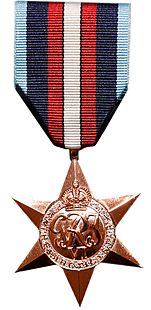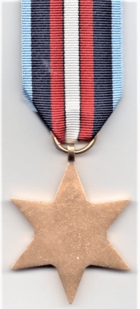Arctic Star facts for kids
Quick facts for kids The Arctic Star |
|
|---|---|
  |
|
| Country | |
| Type | Military campaign medal |
| Eligibility | All Ranks |
| Awarded for | Entry into operational area |
| Campaign(s) | Battle of the Atlantic, for service north of the Arctic Circle |
| Statistics | |
| Established | 19 December 2012 |
| Order of wear | |
| Next (higher) | Atlantic Star |
| Next (lower) | Air Crew Europe Star |
| Related | Atlantic Star |
Ribbon bar |
|
The Arctic Star is a special military medal from the United Kingdom. It was created on December 19, 2012. This medal is given to soldiers, sailors, and aircrew from the British Commonwealth who served during the Second World War. They earned it by serving on the dangerous Arctic Convoys. These convoys sailed north of the Arctic Circle.
Contents
What are the Second World War Stars?
During the Second World War, many special medals were created. These were called "campaign stars." They were given to people who served in different parts of the war.
- The first two stars were made on July 8, 1943. They were the 1939–43 Star and the Africa Star.
- By May 1945, there were eight stars in total.
- The Arctic Star was added much later, on February 26, 2013. This was over 67 years after the war ended.
- Even with the Arctic Star, no one could get more than six campaign stars.
Here are some of the main campaign stars:
- The 1939–1945 Star: This was for service throughout the war.
- The Atlantic Star, Air Crew Europe Star, or France and Germany Star: You could only get one of these.
- The Arctic Star: This is the medal for serving in the Arctic.
- The Africa Star: For service in Africa.
- The Pacific Star or Burma Star: You could only get one of these.
- The Italy Star: For service in Italy.
Everyone who received a campaign star also got the War Medal.
Why was the Arctic Star created?
The Arctic Star was created a long time after the war ended. It was officially approved by the Queen in late 2012. The first medals were made in early 2013.
- People had campaigned for 16 years to get this medal.
- They argued that serving in the Arctic convoys was very different from other sea duties.
- The conditions were extremely harsh and dangerous.
- Winston Churchill himself called these journeys "the worst journey in the world."
- The Arctic Star is special because it's the first British medal to be created using a dead monarch's symbol. This means the Queen who approved it was not the one who was on the medal itself.
Who could get the Arctic Star?
The medal was given to anyone who served north of the Arctic Circle. This included members of the British Armed Forces and the Merchant Navy.
- The qualifying area is north of 66° 32’ North Latitude.
- The time period for service was from September 3, 1939, to May 8, 1945. This covers the entire Second World War in Europe.
Here's a closer look at who qualified:
- Royal Navy and Merchant Navy: Sailors who served anywhere at sea north of the Arctic Circle. This includes ships that were part of convoys to North Russia.
- Air Forces: Aircrew who landed or flew over the Arctic Circle. Ground crew who worked in the area also qualified.
- Army: Soldiers who served on ships in the Arctic or took part in land operations there.
- Civilians: Some civilians who supported military operations in the Arctic could also get the medal.
- Foreign Nationals: People from other countries who served in British or Commonwealth forces could get it. But only if their own government had not given them a similar award.
Getting the Arctic Star did not stop someone from getting other war medals they had earned.
What does the medal look like?
The Arctic Star, like other campaign stars, was designed by engravers at the Royal Mint.
- It is a six-pointed star made of a yellow copper zinc alloy.
- It is about 44 millimeters wide and 50 millimeters tall.
- It has a ring at the top to hang from a ribbon.
The Front (Obverse)
- The front of the medal has the symbol of George VI, who was King during the war. It shows "GRI VI" with a crown above it.
- Around this symbol, it says "THE ARCTIC STAR".
The Back (Reverse)
- The back of the medal is plain.
Naming
- The medals were given out without names on them. However, some people chose to have their names engraved on their medals later.
The Ribbon
- The ribbon for the Arctic Star is 32 millimeters wide.
- It has different colored stripes: light blue, dark blue, red, and white with a thin black line.
- The colors represent the different groups who served:
- Light blue for the Air Forces.
- Dark blue for the Navy.
- Red for the Merchant Navy.
- The white band in the middle, with black edges, represents the Arctic's icy conditions.
Who received the Arctic Star?
The first Arctic Stars were given out on March 19, 2013. Forty World War Two veterans received them in London.
- It is thought that up to 120,000 veterans or their families might be able to get the Arctic Star.
- By July 19, 2018, over 18,600 Arctic Star medals had been given out.
- On September 28, 2014, a Norwegian war veteran named Håkon Nilsen received the Arctic Star. He was the first and only Norwegian to get it after he had passed away. He had served on many Murmansk convoys.
How are the medals worn?
There is a special order for wearing the Second World War campaign stars. This order is based on when each campaign started and how long it lasted.
- The 1939–1945 Star is worn first.
- Then comes the Atlantic Star.
- The Arctic Star is worn after the Atlantic Star.
- After that is the Air Crew Europe Star.
- Then the Africa Star.
- Next, the Pacific Star or Burma Star.
- Then the Italy Star.
- And finally, the France and Germany Star.
- The Defence Medal and the War Medal are worn after all the stars.
- The Arctic Star is worn after the Atlantic Star.
- It is worn before the Air Crew Europe Star.
South Africa
South African military decorations order of wear#Order of wear In 1952, South Africa created its own military medals. These new South African awards were worn before most British medals. However, the Arctic Star was a special case. Even though it was created later, it was still worn in the same order as the other Second World War medals.
Images for kids
See Also






